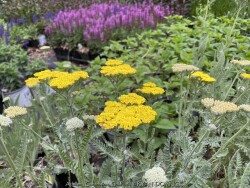

Coronation Gold Yarrow (Achillea 'Coronation Gold') is a vigorous tall growing yarrow with large golden-yellow flower heads. This non-reseeding variety blooms all summer and is considered to be one of the best yarrows for tolerating high humidity. It thrives when planted on a berm with heat and sun in poor soils including clay. Avoid rich soil, excessively windy sites, and too much irrigation.
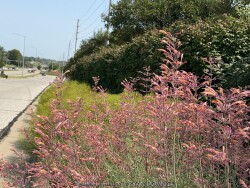

Sunset Agastache (Agastache rupestris) is a cold hardy, native hybrid perennial that blooms from mid to late summer and sporadically into the fall. This variety features a profusion of orange and pinkish flowers that attract hummingbirds and bumblebees. Both the flowers and foliage have a strong minty licorice scent when touched, and aromatic foliage helps to deter both deer and rabbits. Having desert heritage, it resents poor drainage and winter moisture. To counteract that in Kansas, plant in full sun on berm with poor sandy or rocky soil with no irrigation.
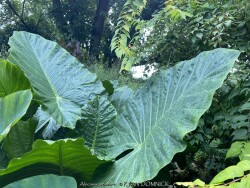

Odora Elephant Ear (Alocasia odora) is typically grown in warmer zones and features giant glossy green leaves creating quite a contrast for other colorful flowers in the garden. Most alocasia are large tropical and subtropical herbaceous perennials with a giant tubers native to areas with a summer monsoon and dry winter. Along with other tropicals and succulents in Kansas, elephant ears are usually grown as summer patio plants. Fertilize, water regularly, and place in full sun. Protect from temperatures below 28 degrees F and move into a cold garage or basement over the winter with minimal watering. Do not allow the pot with rootball to freeze solid or go below 25 degrees for more than a few hours. Allow to go dormant as needed with little care, just cut off dead foliage and place back out in April or May with a time-release fertilizer. Many plants will die back slowly and remain attractive inside for most of the winter. You may also plant these in the ground for an enormous tropical effect! It is possible to overwinter these in the ground in Kansas by placing a giant 12-18" mound of mulch over deeply planted rhizomes. New growth will usually be delayed until June but quickly regains full height. In our trial gardens in Lawrence, KS (zone 6a), three established specimens planted over 12" deep and mulched 6-12" with leaf mulch survived -17 degrees F. During the arctic blast of February, 2021, lows down to -17 degrees F on Feb 16th, 2021 were recorded. The longevity of this cold blast was also impressive: 10 days on a row with highs of 10-15 degrees F or lower, 8 nights of lows in the single digits and negatives, and 36 strait hours of 0 degrees F and mostly lower.
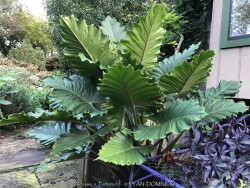

Portora Elephant Ear (Alocasia x Portora) is typically grown in warmer zones and features giant glossy green leaves creating quite a contrast for other colorful flowers in the garden. Most alocasia are large tropical and subtropical herbaceous perennials with a giant tubers native to areas with a summer monsoon and dry winter. Along with other tropicals and succulents in Kansas, elephant ears are usually grown as summer patio plants. Fertilize, water regularly, and place in full sun. Protect from temperatures below 28 degrees F and move into a cold garage or basement over the winter with minimal watering. Do not allow the pot with rootball to freeze solid or go below 25 degrees for more than a few hours. Allow to go dormant as needed with little care, just cut off dead foliage and place back out in April or May with a time-release fertilizer. Many plants will die back slowly and remain attractive inside for most of the winter. You may also plant these in the ground for an enormous tropical effect! It is possible to overwinter these in the ground in Kansas by placing a giant 12-18" mound of mulch over deeply planted rhizomes. New growth will usually be delayed until June but quickly regains full height. This plant can also grow in standing water or as a potted plant in water gardens.


***Description for this hardy tropical available with future update!*** >>>>> Plant delights nursery says "Alstroemeria 'Golden Tiara' is a 2022 Plant Delights/JLBG introduction of a gold-flowered sport of Alstroemeria 'Koice' (Inca Ice) that we found here. We sent plants to Michigan's Walters Gardens for testing, where it has thrived in their Zone 5b field trials. Alstroemeria 'Golden Tiara' forms a 5' wide, dense patch of upright stalks, which begin flowering in early June and continues well into fall, slowing somewhat in the heat of midsummer. The first round of stalks are 2' tall, but the stalks produced later in the summer and fall, top out at 45" tall. The flowers are bright golden yellow with an orange exterior throat. This is a stunning color addition to the line of very hardy princess lilies."
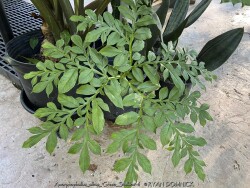

***Description for this hardy tropical available with future update!***>>>>> Plant Delights Nursery says "This little-known but easy-to-grow voodoo lily is native to the Yunnan Province of China. The stalks are either solid green or green with grey spots and are each topped with a glossy green leaf. Amorphophallus albus is a fast offsetting species that forms a nice 2' wide patch (in 5 years) in the woodland garden. In spring, just as the leaf emerges, a 1' tall flower stalk appears alongside it with a 6-8" tall flower perched on top. Each flower resembles a large ivory shell showcasing a white, cigar-like appendage...green at the tip and white at the base." >>>>>>>>>> Voodoo (Amorphophallus konjac) lily is a perennial tuber generally grown as a curiosity for its interesting foliage. The single leaf consists of a stalk (petiole) with mottled pinkish-gray and olive green coloration. The single intricate leaf has horizontal sections giving it a tropical umbrella-like effect. Larger tubers (about the size of a grapefruit or larger) may produce a single "flower" in spring before the foliage appears. The "flower" is actually a large shiny purple to maroon ruffled spathe. When in bloom it produces an odor like a dead animal for 1 day. This is intended to attract the carrion flies that are its natural pollinators. It is possible to overwinter these in the ground in Kansas by placing a 6-12" mound of mulch over deeply planted tubers. New growth will usually be delayed until June but quickly regains full height and will get bigger each year; buried tubers are hardy to zone 6a. They can also be grown as a flowering summer patio plant. If growing as a potted plant and trying to overwinter, allowing the foliage to frost is ok, it will not kill the root system. However, do not allow the pot with rootball to freeze solid or go below 20 degrees for more than a few hours; move into a cold garage or basement over the winter with no watering. Cut back and allow to go dormant and place entire pot back out in April or May with a time-release fertilizer. Plants can get huge and exotic looking as a potted patio plant. Grown in Japan and Korea as an edible corm. Testing in Lawrence KS display gardens has been successful; surviving temperatures of -11F (2024)
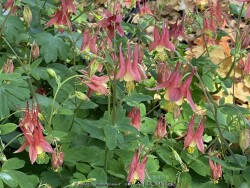

Aquilegia canadensis is a columbine native to Kansas with more tolerance for drought, heat and humidity. It still prefers cool nights preferring rich, moist soils with light to moderate shade. By keep soils uniformly moist after during and after bloom, the attractive foliage will last into June or July in Kansas. When foliage depreciates from drought or leaf miners, the plants may be cut to the ground with some regrowth and flowering possible in the fall. Flowers are reddish pink with yellow shades inside. Great for hummingbirds!
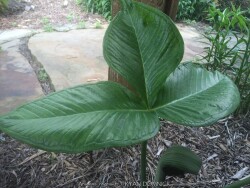

Japanese Cobra Lily (Arisaema ringens) is planted for its bright green foliage and bazaar "Cobra" hood-like flowers. Native to rich Japanese forests in humusy, medium to wet, well-drained soil in part shade to full shade, it needs a good location in the garden and will be a focal point. If foliage depreciates from drought, the plants may be cut to the ground with some regrowth and flowering possible in the fall. Combine with shade garden plants that will fill the space in summer such as hostas. Although this aroid offsetts, it is rare and uncommonly available for sale.
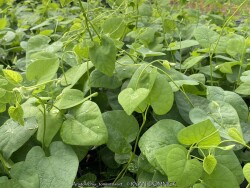

Dutchman's Pipe / Woolly Pipevine (Aristolochia tomentosa) is one of the most rapidly growing vines in out library capable of growing 15-30' in one summer! Native to eastern North America including Missouri, it typically occurs along moist woods and along streams. It can fill a large trellis or arbor with bright green foliage up to 12" across creating the most dense shade of any vine. It needs typical garden soil and regular moisture and is intolerant of drought. In Eastern Kansas, typically our 40 inches of rainfall is close to sufficient without much extra water if planted in good soils. The flowers are 1-2" across but are usually not noticed but is absolutely gorgeous with foliage alone.
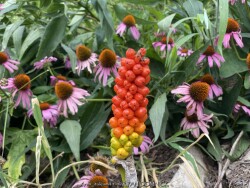

Italian Painted Arum (Arum italicum 'Pictum') is native to the Mediterranean region. It has a reversed or off-schedule life cycle; growing when other plants have already shed their leaves to take advantage of sunlight and lack of competition. It is often planted for its unusual evergreen leaf pattern and color resembling a bright green house plant growing outside in winter. Foliage goes dormant by June but is followed by naked stalks emerging from the ground with reddish orange berries. Foliage re-appears in fall and lasts well into winter untouched. If low temperatures hit 0 degrees F, foliage finally dies back to the ground and re-emerges in early spring to repeat the life cycle. If low temperatures hit -15 degrees F, it may kill an un-mulched plant; protect any zone 5/6 perennial with a 2-3" thick layer of mulch. Grow in average to rich well drained garden soil in full sun or full shade with everything in between. Moderate dry shade does not seem to be a problem because arum goes dormant anyways in the heat of summer. This holds true for planting in sunny locations to. Combine with shade garden plants that will fill the space in summer such as hostas or solomon seal. Also great when combined with late-emerging spring perennials (like plumbago, hardy hibiscus, and orange butterfly weed) because it fills that early spring space starting to grow extremely early with freeze-resistant foliage. Then later in the summer when Arum goes dormant, these plants hide the dying foliage and void left in the garden; what a great way for two species to share the same garden space! It has potential to be invasive in parts of the country such as the Pacific Northeast USA but not in Kansas. It is very stable but does not self-seed or spread in Lawrence, KS gardens; bulb offsets develop but only thicken the existing clump over time. Considered to be a great permatanet multi-season perennial for your garden.
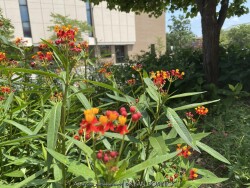

***Description for this plant available with future update!***
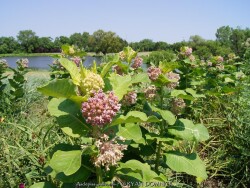

***Description for this perennial available with future update!***
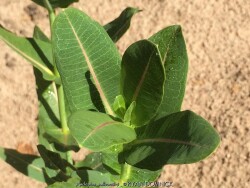

***Description for this perennial available with future update!***
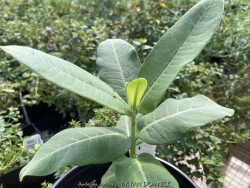

***Description for this perennial available with future update!***
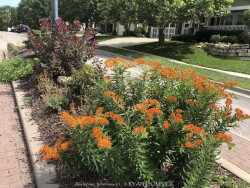

Orange Butterfly Milkweed (Asclepias tuberosa) is a native wildflower with bright orange flowers occurring mostly in dry open habitats and is very common in the prairies and grasslands of the Midwest and Great Plains. Common in Kansas, this beautiful native wildflower is also found from Maine to South Dakota to the desert southwest to Florida. In ideal locations established Butterfly Weeds are very showy with multiple flowering stems spreading across the two foot high plant. Mature plants also have a deep tap root that extends down a foot or more allowing them superb drought tolerance. This rugged species thrives in sunny locations, in dry sandy soil or well-drained loam. More permanent locations include limestone bluffs, rocky prairies, and Great Plains. This wildflower also colonizes readily with wind blown fluffy seeds and will grow under the mower blades sometimes completing their flowering before yearly mowing along state highways. Foliage is often green, upright and attractive. Flowering is long lasting usually 4-6 weeks with interesting seed pods developing later. These eventually open and seeds float away. Reseeding is rare in the garden as mulch will generally eliminate that possibility. In the landscape, Orange Butterfly Weed can be used in any dry soil situation including berms, hot south or west side of the house, or any other full sun area. These will grow in poor rocky, sandy or clayish soils and even rich organic soils as a beautiful flowering annual. With our average 40 inches of rain per year in eastern Kansas, extra irrigation is not recommended. When used as an annual with irrigation and rich garden soil, you can expect the amazing growth and summer flowering followed by a probable root rot in the winter. Orange Butterfly Weed can be planted in parking lot medians and other hell strips as a very durable groundcover. Orange Butterfly Weed can also thrive in an above-ground perennial planter (with appropriate potting soil) year-round surviving the winter coldness in Eastern Kansas (zone 6a/5b). In any situation, combine with any other flower colors except orange. There is quite a lot of diversity within the species so plants from different locales will have different foliage and flower shades adapted to the site. Flower color can range from almost red to pure yellow and everything in between.


The False Indigo species (Baptisia) features beautiful compact bluish green leaves arranged in groups of three. Like many members in the legume family, they are nitrogen fixing plants which means they produce their own nitrogen in the soil through a symbiotic relationship with bacteria. The flowers bloom above the foliage normally in April and May. Common baptisia flower colors include white, purple, lavender, yellow, and pink as well as uncommon colors ranging from deep purple to maroon and even coppery orange. Considered a great North American native three season plant, the foliage always emerges very attractive followed by flowers that do not need deadheading. Foliage generally lasts pretty nice through hot summers and into fall turning black with first freeze. Seed pods also turn charcoal black when ripe and have considerable ornamental interest and useful in dried flower arrangements. At some point in the fall, it can be cut down early for a clean look or left for winter interest. Baptisia generally do well in droughty clay soils in full to part sun. There is only one pest that may create problems called the Genista Broom Moth. It may occur in Kansas when weather conditions are consistently dry and over 95 degrees F. It is treatable if you act fast but if not, it only destroys the foliage late in the season and does not kill the plant. Baptisia has several enormous spreading taproots which store water and energy and can make transplanting difficult. Plantings look good as specimen or in small groups; and it's ok even preferable if they grow together and touch other plants. That helps eliminate available sunlight and discourages weeds. It is hard to picture a native plant garden or any perennial garden without Baptisia. Considered a once "it's there, it's always there" plant. Baptisia 'American Goldfinch' >>>>>>>Gorgeous, golden yellow flower spikes rise up above its wide habit. This is one of the most floriferous Baptisia we offer, producing loads of brightly colored spikes for many weeks. After the blooming season, 'American Goldfinch' produces attractive round seed pods in the fall. This is the perfect specimen for filling in a large space in your garden or for mass plantings in landscapes. >>>>> This extremely long-lived perennial could be used instead of a shrub in landscape settings, with minimal care required to thrive year after year.
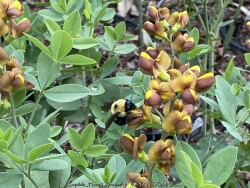

The False Indigo species (Baptisia) features beautiful compact bluish green leaves arranged in groups of three. Like many members in the legume family, they are nitrogen fixing plants which means they produce their own nitrogen in the soil through a symbiotic relationship with bacteria. The flowers bloom above the foliage normally in April and May. Common baptisia flower colors include white, purple, lavender, yellow, and pink as well as uncommon colors ranging from deep purple to maroon and even coppery orange. Considered a great North American native three season plant, the foliage always emerges very attractive followed by flowers that do not need deadheading. Foliage generally lasts pretty nice through hot summers and into fall turning black with first freeze. Seed pods also turn charcoal black when ripe and have considerable ornamental interest and useful in dried flower arrangements. At some point in the fall, it can be cut down early for a clean look or left for winter interest. Baptisia generally do well in droughty clay soils in full to part sun. There is only one pest that may create problems called the Genista Broom Moth. It may occur in Kansas when weather conditions are consistently dry and over 95 degrees F. It is treatable if you act fast but if not, it only destroys the foliage late in the season and does not kill the plant. Baptisia has several enormous spreading taproots which store water and energy and can make transplanting difficult. Plantings look good as specimen or in small groups; and it's ok even preferable if they grow together and touch other plants. That helps eliminate available sunlight and discourages weeds. It is hard to picture a native plant garden or any perennial garden without Baptisia. Considered a once "it's there, it's always there" long lived plant. Baptisia 'Honey Roasted' features long 10" spikes of dark mahogany flowers have bright yellow keels, producing a wonderful bicolor effect. The bushy habit is jam-packed with flowers when it is in bloom early in the growing season. Flowers lighten to yellow as the flowers mature. This extremely long-lived perennial could be used instead of a shrub in landscape settings, with minimal care required to thrive year after year.
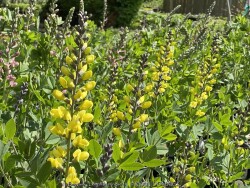

The False Indigo species (Baptisia) features beautiful compact bluish green leaves arranged in groups of three. Like many members in the legume family, they are nitrogen fixing plants which means they produce their own nitrogen in the soil through a symbiotic relationship with bacteria. The flowers bloom above the foliage normally in April and May. Common baptisia flower colors include white, purple, lavender, yellow, and pink as well as uncommon colors ranging from deep purple to maroon and even coppery orange. Considered a great North American native three season plant, the foliage always emerges very attractive followed by flowers that do not need deadheading. Foliage generally lasts pretty nice through hot summers and into fall turning black with first freeze. Seed pods also turn charcoal black when ripe and have considerable ornamental interest and useful in dried flower arrangements. At some point in the fall, it can be cut down early for a clean look or left for winter interest. Baptisia generally do well in droughty clay soils in full to part sun. There is only one pest that may create problems called the Genista Broom Moth. It may occur in Kansas when weather conditions are consistently dry and over 95 degrees F. It is treatable if you act fast but if not, it only destroys the foliage late in the season and does not kill the plant. Baptisia has several enormous spreading taproots which store water and energy and can make transplanting difficult. Plantings look good as specimen or in small groups; and it's ok even preferable if they grow together and touch other plants. That helps eliminate available sunlight and discourages weeds. It is hard to picture a native plant garden or any perennial garden without Baptisia. Considered a once "it's there, it's always there" long lived plant. Baptisia 'Lemon Meringue' is an excellent vigorous yellow flowered selection. It forms an upright, vase-shaped mound of attractive blue-green foliage topped with long, charcoal stems which carry the lemon yellow flowers in late spring to early summer. The contrast of dark stems with light flowers really pops in the landscape, delivering an excellent floral display. Ornamental seed pods extend the season of interest into fall. This extremely long-lived perennial could be used instead of a shrub in landscape settings, with minimal care required to thrive year after year. This plant is a member of the DECADENCE® series from Walters Gardens, Inc.
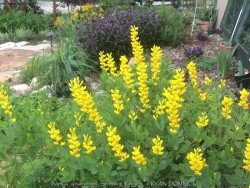

The False Indigo (Baptisia species) features beautiful compact bluish green leaves arranged in groups of three. Like many members in the legume family, they are nitrogen fixing plants which means they produce their own nitrogen in the soil through a symbiotic relationship with bacteria. The flowers bloom above the foliage normally in April and May. Common baptisia flower colors include white, purple, lavender, yellow, and pink as well as uncommon colors ranging from deep purple to maroon and even coppery orange. Considered a great North American native three season plant, the foliage always emerges very attractive followed by flowers that do not need deadheading. Foliage generally lasts pretty nice through hot summers and into fall turning black with first freeze. Seed pods also turn charcoal black when ripe and have considerable ornamental interest and useful in dried flower arrangements. At some point in the fall, it can be cut down early for a clean look or left for winter interest. Baptisia generally do well in droughty clay soils in full to part sun. There is only one pest that may create problems called the Genista Broom Moth. It may occur in Kansas when weather conditions are consistently dry and over 95 degrees F. It is treatable if you act fast but if not, it only destroys the foliage late in the season and does not kill the plant. Baptisia has several enormous spreading taproots which store water and energy and can make transplanting difficult. Plantings look good as specimen or in small groups; and it's ok even preferable if they grow together and touch other plants. That helps eliminate available sunlight and discourages weeds. It is hard to picture a native plant garden or any perennial garden without Baptisia. Considered a once "it's there, it's always there" plant. Baptisia sphaerocarpa 'Screaming Yellow' is one of the best yellows, featuring bright golden yellow flowers and more rounded seed pods.
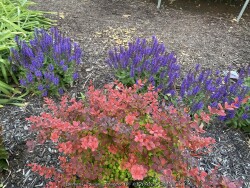

Bright and cheery, this new barberry (Berberis 'Sunjoy Tangelo') has vivid orange new growth that develops a distinctive chartreuse margin as the season goes on. Sunjoy® Tangelo Barberry is stronger growing than other variegated cultivars, it is colorful in the landscape from spring to fall. Certified wheat-rust resistant. Maintenance Notes: Prefers well-drained soils. May be pruned to shape in summer. In Eastern Kansas, this cultivar performs WELL with just about everything nature has to challenge it! Heat and drought are tolerated well. Cold tolerance is no problem. No disease or pest problems. Great plant for berms in full sun. No other plant can match its bright orange-red foliage: I personally love the combination of planting next to blue or purple flowers but the combinations are endless! All Proven Winners® plants are legally propagated, healthy and vigorous, true to name, and tagged with color pictures and growing information.
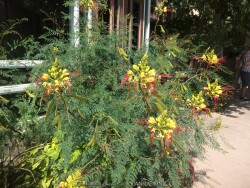

Hardy Bird of Paradise (Caesalpinia gilliesii) is a surprisingly hardy shrub from South America native to Argentina and Uruguay. The extremely fine textured bipennate foliage is fern-like and resembles Mimosa or Amorpha. During spring and summer the lovely foliage takes on a bluish green color. By late summer if conditions are optimal, beautiful flowers appear. The flowers are light yellow with protruding red hair-like stamens that are very showy, drawing in curious visitors. By late fall in our zone 6 climate, the foliage drops and typically the above ground woody part of the shrub freezes back and behaves like a Crapemyrtle or a Butterfly Bush. Trim dead growth in mid-spring and enjoy the new beautiful regrowth by early summer. In order for this shrub to flower, it needs to be well-established, in full sun, and preferably on the south or west side of a foundation. Hardy Bird of Paradise need average to dry well drained soil especially in the winter. Hardiness should not be an issue after seeing mature established plants at the Denver Botanic Garden (zone 5b) in full bloom. The Botanic Garden at Oklahoma State University (zone 7a) also has a few decades old specimens. Wet winter soils could limit its success in zone 5-7 areas in the Eastern United States. It has been thriving in our trial gardens and at several residential gardens in Lawrence, KS (zone 6a) 5-7 years ago. During the arctic blast of February, 2021, lows down to -17 degrees F on Feb 16th, 2021 were recorded. The longevity of this cold blast was also impressive: 10 days on a row with highs of 10-15 degrees F or lower, 8 nights of lows in the single digits and negatives, and 36 straight hours of 0 degrees F and mostly lower. It is virtually unknown in most garden centers but worthy of more wide-scale use especially in hot locations.
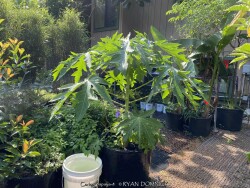

***Description for this plant available with future update!***Papaya (Tropical), is also known as Carica papaya


The Saguaro Cactus (Carnegiea gigantea) is probably the most well known iconic cactus out there. Native to the Sonoran Desert in Arizona and Mexico, it's usually grown as a patio or house plant in Kansas. In the wild, established saguaro cacti are hardy to 15 degrees F for short periods of time making them the most cold tolerant columnar tree cactus out there. Growth rates are astonishingly slow: a plant the size od a softball may already be 10-15 years old. A 12" tall specimen may be 20-30 years old. The first arm usually develops around 75 years and plants can live for 200-300 years in hte wild. Grow in full sun with no extra watering except that which comes from rainfall. Repotting may or may not be needed depending on how large you want the plant to grow; plants can continue to grow taller and tolerate extremely root-bound pots but may need wind bracing. If repotting, make sure to use a sharp draining low organic cactus mix with plenty of sand and perlite. Potted plants are hardy to at least 30 degrees F for a short time if kept dry so you are ok if you miss the first light frost. Do not allow the pot with rootball to freeze solid though. Before extreme cold occurs, move to a bright interior window over the winter with no watering and keep above freezing. As a winter house plant, it will look presentable all winter long with just no waterings.(also to prevent soft winter growth) As a permanent house plant, provide bright light and allow the soil to dry between waterings for many years of carefree enjoyment. Plants grown permanently indoors may begin to elongate stretching for light and lose their spine color. It can be hard to reproduce the intense UV sunlight they need so moving outside for the summer is best. Generally if moving outside for the summer, allow 1-2 weeks of part shade or morning sun before placing in full sun. Plants with time to acclimate will thrive in full sun but be careful not to rush it or sunburning will occur. Potted plants are very low maintenance. I have never seen any insect problems on this plant.
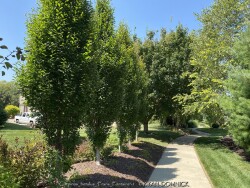

***Tree descriptions available with future update!***
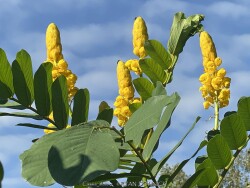

Yellow Candlestick Tree (Cassia / Senna alata) is grown in Kansas as a giant annual capable of reaching 6 to 12 feet in one season. Growth is slow at first in Spring when temperatures are still cool. It is native to tropical rainforests in Mexico and South America generally fulfilling the role of a pioneer species rapidly colonizing disturbed areas. Bright green bi-pinnate leaves are symmetrically arranged and very tropical looking. As branching and growth form develop, the overall geometrical effect is stunning even without flowers yet. Finally by September and all through October until frost, yellow candle-like flowers tower over the foliage. Some plants may have up to 50-100 flower spikes at one time. Cut down promptly after frost as there is no winter interest. Seeds rarely have time to develop in our shorter growing season but it is possible to harvest seeds if the first fall freeze is late. Yellow Candlestick Tree grows fastest in rich well drained soils and plenty of water. Growth is equally impressive in most Kansas soils including heavy clay as long as watering is sufficient. Yellow Candlestick Tree needs hot summers, full sun, and warm humid conditions to thrive. When grown in a large pot, it is very difficult to overwinter inside so it's best to buy new plants each year. This plant has also evolved and interesting relationship with ants, providing nectary glands (food) in exchange for protection from insect pests. Use Yellow Candlestick Tree where you need to fill up a lot of space in a hurry or just like lots of yellow flowers in the fall when other things are not blooming. Interestingly, the foliage is sensitive to light, folding up neatly at sunset and opening up the nest morning.
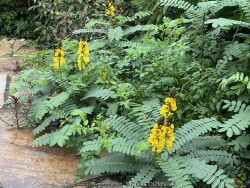

***Description for this plant available with future update!***
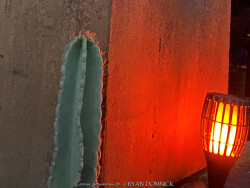

Grown for its beautiful bluish-green skin and showy night-blooming white flowers. Unlike most columnar cacti, Peruvian apple cactus (Cereus peruvianus) will bloom at a young age in a pot when about 3' tall or more. This cactus is usually grown as a patio or house plant in Kansas and blooms in late summer into early fall. Flowers only last one night! In the wild, this species is hardy to 20-25 degrees F for short periods of time. Grow in full sun with optional extra watering including that which comes from rainfall. Potted plants are very low maintenance. I have never seen any insect problems on this plant. Potted plants are capable of growing 10' tall or more in a small 7gal pot. Succulents are usually spineless and grown for their beautiful shapes, color and texture. Cacti are known for their spines, unusual shapes and beautiful flowers. Both succulents and cacti store water in their fleshy tissues. And can survive long periods without water. Cacti and succulents are usually grown as a deck/patio plant or house plant in Kansas. Grow in full sun with little to no extra watering except that which comes from rainfall. Generally, plants may be brought out in Late May through Early October in our zone 6a Lawrence, KS climate. To play is safe, potted plants are best moved in before autumn leaves begin to drop and before night temperatures get below 45 degrees F. It is very important to avoid the combination of wet and cold. Move to a bright interior window over the winter with little to no watering and keep above 50 degrees F. As a winter house plant, it will look presentable all winter long with little to no waterings. As a permanent house plant, provide bright light and allow the soil to dry completely between waterings and you will get many years of carefree enjoyment. Plants grown permanently indoors may eventually begin to elongate stretching for light and lose their spine color. It can be hard to reproduce the intense UV sunlight they need when growing indoors so moving outside for the summer is best. Generally if moving outside for the summer, allow 1-2 weeks of part shade or morning sun before placing in full sun. Plants with time to acclimate will thrive in full sun but be careful not to rush it or sunburning may occur. Repotting may or may not be needed depending on how large you want the plant to grow; plants can continue to grow taller and tolerate extremely root-bound pots but may need wind bracing. If repotting, make sure to use a sharp draining low organic cactus mix with plenty of sand and perlite but avoid peat moss. The “soil” most commercial cacti are potted in to too peaty and light weight. This soil becomes hydrophobic and shrinks after becoming bone dry and difficult to re wet again. Cacti never grow in peat-based soils in nature; this “Soil” is only good for shipping because of the light weight. Potted plants are very low maintenance but watch for scale and mealybugs that may hide beneath the cover of spines. The best pest removal approach is to periodically wash the cactus off. Achieve this with a water nozzle or hose breaker turned mostly off to increase the pressure from the blast of water. This high-pressured water kills the pests without damaging the thick cactus skin. Here are some little-known or rare factoids about cacti: 1. The "spines" are actually modified leaves filled with sap at first, then quickly drying out to form the spines! 2. Many cacti have bright colored flowers that mainly attract bees, while some tubular flowering types attract hummingbirds and bats. 3. Late on the evolutionary timeline, cacti fossils are rare to non-existent. Cacti are native almost exclusively to the Americas, while succulents can include a much larger plant palette be from any dry area in the world. 4. Some cactus plants have been known to survive more than 2 years without water. 5. Some cacti first evolved in a dry climate that later became wetter again. For example: several jungle species live as epiphytes in trees to achieve the fast drainage they need.


Grown for its beautiful bluish-green skin and showy night-blooming white flowers. Unlike most columnar cacti, Peruvian apple cactus (Cereus peruvianus) will bloom at a young age in a pot when about 3' tall or more. This cactus is usually grown as a patio or house plant in Kansas and blooms in late summer into early fall. Flowers only last one night! In the wild, this species is hardy to 20-25 degrees F for short periods of time. Grow in full sun with optional extra watering including that which comes from rainfall. Potted plants are very low maintenance. I have never seen any insect problems on this plant. Potted plants are capable of growing 10' tall or more in a small 7gal pot. Succulents are usually spineless and grown for their beautiful shapes, color and texture. Cacti are known for their spines, unusual shapes and beautiful flowers. Both succulents and cacti store water in their fleshy tissues. And can survive long periods without water. Cacti and succulents are usually grown as a deck/patio plant or house plant in Kansas. Grow in full sun with little to no extra watering except that which comes from rainfall. Generally, plants may be brought out in Late May through Early October in our zone 6a Lawrence, KS climate. To play is safe, potted plants are best moved in before autumn leaves begin to drop and before night temperatures get below 45 degrees F. It is very important to avoid the combination of wet and cold. Move to a bright interior window over the winter with little to no watering and keep above 50 degrees F. As a winter house plant, it will look presentable all winter long with little to no waterings. As a permanent house plant, provide bright light and allow the soil to dry completely between waterings and you will get many years of carefree enjoyment. Plants grown permanently indoors may eventually begin to elongate stretching for light and lose their spine color. It can be hard to reproduce the intense UV sunlight they need when growing indoors so moving outside for the summer is best. Generally if moving outside for the summer, allow 1-2 weeks of part shade or morning sun before placing in full sun. Plants with time to acclimate will thrive in full sun but be careful not to rush it or sunburning may occur. Repotting may or may not be needed depending on how large you want the plant to grow; plants can continue to grow taller and tolerate extremely root-bound pots but may need wind bracing. If repotting, make sure to use a sharp draining low organic cactus mix with plenty of sand and perlite but avoid peat moss. The “soil” most commercial cacti are potted in to too peaty and light weight. This soil becomes hydrophobic and shrinks after becoming bone dry and difficult to re wet again. Cacti never grow in peat-based soils in nature; this “Soil” is only good for shipping because of the light weight. Potted plants are very low maintenance but watch for scale and mealybugs that may hide beneath the cover of spines. The best pest removal approach is to periodically wash the cactus off. Achieve this with a water nozzle or hose breaker turned mostly off to increase the pressure from the blast of water. This high-pressured water kills the pests without damaging the thick cactus skin. Here are some little-known or rare factoids about cacti: 1. The "spines" are actually modified leaves filled with sap at first, then quickly drying out to form the spines! 2. Many cacti have bright colored flowers that mainly attract bees, while some tubular flowering types attract hummingbirds and bats. 3. Late on the evolutionary timeline, cacti fossils are rare to non-existent. Cacti are native almost exclusively to the Americas, while succulents can include a much larger plant palette be from any dry area in the world. 4. Some cactus plants have been known to survive more than 2 years without water. 5. Some cacti first evolved in a dry climate that later became wetter again. For example: several jungle species live as epiphytes in trees to achieve the fast drainage they need.


Jessamine / Hardy Cestrums are relatively new and upcomming plant. Our mix of species were purchased from Bustani Plant Farm in Stillwater, OK. Mostly listed as hardy to zone 7, you can easily push this into zone 6 with a layer of thick winter mulch. Mix of the following species proven hardy in Lawrence, KS: Cestrum aurantiacum, Cestrum ‘Greystone Gold’, Cestrum ‘Orange Peel’. Many visitors in the display garden are amazed by the uniqueness and beauty. It really resembles a "yellow flowering lilac" with flowers and foliage. Similar to a Crapemyrtle, These Cestrum varieties are hardy outside when grown as a perennial and cut back hard each year. During the growing season, fertilize, water regularly, and plant in full sun. Plant a little deep at first; about 2-3" deep with 4-6" of mulch. In our trial gardens in Lawrence, KS (zone 6a), the following varieties survived after being mulched 6-12" with leaf mulch. During the arctic blast of January, 2024, lows down to -11 degrees F on Jan 10th, 2024 were recorded. The longevity of this cold blast was also impressive: 4 days on a row with single digit highs including 1 day with a negative high(-2F), 4 nights of lows in negatives(-8For lower), and 48 straight hours of 0 degrees F and mostly lower.


Jessamine / Hardy Cestrums are relatively new and upcomming plant. Our mix of species were purchased from Bustani Plant Farm in Stillwater, OK. Mostly listed as hardy to zone 7, you can easily push this into zone 6 with a layer of thick winter mulch. Mix of the following species proven hardy in Lawrence, KS: Cestrum aurantiacum, Cestrum ‘Greystone Gold’, Cestrum ‘Orange Peel’. Many visitors in the display garden are amazed by the uniqueness and beauty. It really resembles a "yellow flowering lilac" with flowers and foliage. Similar to a Crapemyrtle, These Cestrum varieties are hardy outside when grown as a perennial and cut back hard each year. During the growing season, fertilize, water regularly, and plant in full sun. Plant a little deep at first; about 2-3" deep with 4-6" of mulch. In our trial gardens in Lawrence, KS (zone 6a), the following varieties survived after being mulched 6-12" with leaf mulch. During the arctic blast of January, 2024, lows down to -11 degrees F on Jan 10th, 2024 were recorded. The longevity of this cold blast was also impressive: 4 days on a row with single digit highs including 1 day with a negative high(-2F), 4 nights of lows in negatives(-8For lower), and 48 straight hours of 0 degrees F and mostly lower.


Jessamine / Hardy Cestrums are relatively new and upcomming plant. Our mix of species were purchased from Bustani Plant Farm in Stillwater, OK. Mostly listed as hardy to zone 7, you can easily push this into zone 6 with a layer of thick winter mulch. Mix of the following species proven hardy in Lawrence, KS: Cestrum aurantiacum, Cestrum ‘Greystone Gold’, Cestrum ‘Orange Peel’. Many visitors in the display garden are amazed by the uniqueness and beauty. It really resembles a "yellow flowering lilac" with flowers and foliage. Similar to a Crapemyrtle, These Cestrum varieties are hardy outside when grown as a perennial and cut back hard each year. During the growing season, fertilize, water regularly, and plant in full sun. Plant a little deep at first; about 2-3" deep with 4-6" of mulch. In our trial gardens in Lawrence, KS (zone 6a), the following varieties survived after being mulched 6-12" with leaf mulch. During the arctic blast of January, 2024, lows down to -11 degrees F on Jan 10th, 2024 were recorded. The longevity of this cold blast was also impressive: 4 days on a row with single digit highs including 1 day with a negative high(-2F), 4 nights of lows in negatives(-8For lower), and 48 straight hours of 0 degrees F and mostly lower.
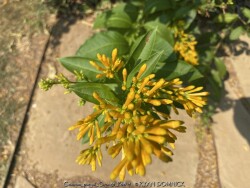

Jessamine / Hardy Cestrums are relatively new and upcomming plant. Brighten up summertime with Juiced® Orange jessamine. This compact hybrid jessamine has deliciously colorful blooms and bright glossy foliage. These citrus-hued, tubular flowers attract both butterflies and hummingbirds. Blooming from spring to frost, this tropical evergreen has dark, glossy foliage and a superior, bushy habit along with easy care: no need to trim to keep the blooms coming! In colder climates, it can be grown as a patio plant and overwintered in a sunroom. This is a fun and colorful South American native that offers uniqueness and novelty that everyone will crave. Mostly listed as hardy to zone 7, you can easily push this into zone 6 with a layer of thick winter mulch. Many visitors in the display garden are amazed by the uniqueness and beauty. It really resembles a "yellow flowering lilac" with flowers and foliage. Similar to a Crapemyrtle, Cestrums are hardy outside when grown as a perennial and cut back hard each year. It will re-grow from the roots and still flower on new wood by mid-summer. During the growing season, fertilize, water regularly, and plant in full sun. Plant a little deep at first; about 2-3" deep with 4-6" of mulch. In our trial gardens in Lawrence, KS (zone 6a), the following varieties survived after being mulched 6-12" with leaf mulch. During the arctic blast of January, 2024, lows down to -11 degrees F on Jan 10th, 2024 were recorded. The longevity of this cold blast was also impressive: 4 days on a row with single digit highs including 1 day with a negative high(-2F), 4 nights of lows in negatives(-8For lower), and 48 straight hours of 0 degrees F and mostly lower. PROVEN WINNERS variety.


Jessamine / Hardy Cestrums are relatively new and upcomming plant. Our mix of species were purchased from Bustani Plant Farm in Stillwater, OK. Mostly listed as hardy to zone 7, you can easily push this into zone 6 with a layer of thick winter mulch. Mix of the following species proven hardy in Lawrence, KS: Cestrum aurantiacum, Cestrum ‘Greystone Gold’, Cestrum ‘Orange Peel’. Many visitors in the display garden are amazed by the uniqueness and beauty. It really resembles a "yellow flowering lilac" with flowers and foliage. Similar to a Crapemyrtle, These Cestrum varieties are hardy outside when grown as a perennial and cut back hard each year. During the growing season, fertilize, water regularly, and plant in full sun. Plant a little deep at first; about 2-3" deep with 4-6" of mulch. In our trial gardens in Lawrence, KS (zone 6a), the following varieties survived after being mulched 6-12" with leaf mulch. During the arctic blast of January, 2024, lows down to -11 degrees F on Jan 10th, 2024 were recorded. The longevity of this cold blast was also impressive: 4 days on a row with single digit highs including 1 day with a negative high(-2F), 4 nights of lows in negatives(-8For lower), and 48 straight hours of 0 degrees F and mostly lower.


***Description for this plant available with future update!***
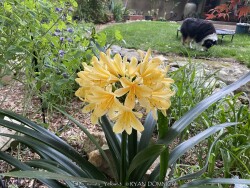

Clivia (Clivia miniata) has attractive dark green, wide, glossy, curved foliage along with long lasting bright yellow flowers followed by red fruits. Also sometimes called Bush lily or Kaffir lily, it is native to seasonal semi-dry woodland habitats in South Africa. It is best used as a houseplant or full-shade summer patio plant in Kansas. Place in full shade in areas where occasional extra watering can happen including that which comes from rainfall. Repotting may or may not be needed depending on how large you want the plant to grow; plants can continue to grow thicker and tolerate extremely root-bound pots. Potted plants are hardy to at least 30 degrees F for a short time but try not to miss the first light frost. Move into a cold garage, basement, or bright window over the winter with occasional to no watering. Flowering is more reliable with root-bound plants given a cool 2-4 month dormant season with temperatures in the 40-50 degree F range with little to no winter watering. Larger plants can survive 3-5 months without water in the winter if allowed to have a healthy outdoor growing season. As a winter house plant, it will look presentable all winter long with just a few waterings. As a permanent house plant, provide bright light and allow the soil to dry between waterings for many years (even decades) of carefree enjoyment. Potted plants grow very slow and are very low maintenance needing only old leaves removed once per year. Mealy bugs can be a problem with permanent indoor house plants but will go away if grown outside during the summer or never introduced in the first place. Either way, take outside and administer sharp blasts of hose water and/or horticultural oil spray to eliminate this (only) pest problem. Note that clivia will sunburn rapidly if accidently left in full sun even for a few hours, even in cooler weather in spring or fall so be aware of its needs and protect from all direct outdoor sunlight. Indoor grown plants however, can handle direct sun (UV blocked light) from windows. Yellow clivia is rare and will command a higher price than most other houseplants.
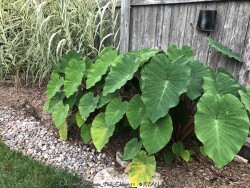

Pink China Hardy Elephant Ear (Colocasia 'Pink China') are typically grown for their large tropical foliage and pink stems. The plants are temperate and subtropical herbaceous perennial bulbs native to areas with a summer monsoon season and dry winter. Pink China Hardy Elephant Ear is hardy outside as a perennial when established and with minimal effort at least up to zone 6a. During the growing season, fertilize, water regularly, and plant in full sun. Plant these bulbs in the ground at least 3-6" deep with 3-4" of mulch. Foliage may look bedwraggled by fall if drought stressed so it is ok to cut back foliage at that time. Plants spread by running ryizomes but are easy to pull up if undesired. They can also be grown as a flowering summer patio plant. If growing as a potted plant and trying to overwinter, allowing the foliage to frost is ok, it will not kill the root system. However, do not allow the pot with rootball to freeze solid or go below 20 degrees for more than a few hours; move into a cold garage or basement over the winter with no watering. Cut back and allow to go dormant and place entire pot back out in April or May with a time-release fertilizer. If digging from the ground in colder zones, just save a big chunk with the dirt intact and place into a large pot in the garage. In our display garden in Lawrence, KS (zone 6a), several established specimens planted over 4-6" deep and mulched 2-3" with wood mulch survived -17 degrees F. During the arctic blast of February, 2021, lows down to -17 degrees F on Feb 16th, 2021 were recorded. The longevity of this cold blast was also impressive: 10 days on a row with highs of 10-15 degrees F or lower, 8 nights of lows in the single digits and negatives, and 36 straight hours of 0 degrees F and mostly lower. This plant can also be used as a marginal aquatic plant growing in shallow water. It can also grow as a bog plant needing constantly moist soil rich in organic matter. As a rain garden plant, it will thrive is a depressed area in the landscape that collects rain water from a roof during spring and summer periods of rain but then go dormant if the water hole dries out completely.


Pink China Hardy Elephant Ear (Colocasia 'Pink China') are typically grown for their large tropical foliage and pink stems. The plants are temperate and subtropical herbaceous perennial bulbs native to areas with a summer monsoon season and dry winter. Pink China Hardy Elephant Ear is hardy outside as a perennial when established and with minimal effort at least up to zone 6a. During the growing season, fertilize, water regularly, and plant in full sun. Plant these bulbs in the ground at least 3-6" deep with 3-4" of mulch. Foliage may look bedwraggled by fall if drought stressed so it is ok to cut back foliage at that time. Plants spread by running ryizomes but are easy to pull up if undesired. They can also be grown as a flowering summer patio plant. If growing as a potted plant and trying to overwinter, allowing the foliage to frost is ok, it will not kill the root system. However, do not allow the pot with rootball to freeze solid or go below 20 degrees for more than a few hours; move into a cold garage or basement over the winter with no watering. Cut back and allow to go dormant and place entire pot back out in April or May with a time-release fertilizer. If digging from the ground in colder zones, just save a big chunk with the dirt intact and place into a large pot in the garage. In our display garden in Lawrence, KS (zone 6a), several established specimens planted over 4-6" deep and mulched 2-3" with wood mulch survived -17 degrees F. During the arctic blast of February, 2021, lows down to -17 degrees F on Feb 16th, 2021 were recorded. The longevity of this cold blast was also impressive: 10 days on a row with highs of 10-15 degrees F or lower, 8 nights of lows in the single digits and negatives, and 36 straight hours of 0 degrees F and mostly lower. This plant can also be used as a marginal aquatic plant growing in shallow water. It can also grow as a bog plant needing constantly moist soil rich in organic matter. As a rain garden plant, it will thrive is a depressed area in the landscape that collects rain water from a roof during spring and summer periods of rain but then go dormant if the water hole dries out completely.
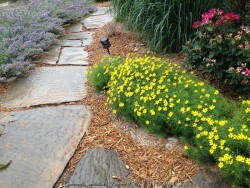

Zagreb coreopsis is a compact gold flowering variety with fine textured foliage. Coreopsis is native to most of eastern North America. Flowers occur in midsummer for a few weeks then turn black to add some interest. Foliage is a rich green turning to yellow briefly in the fall. It spreads gently by rhizomes with density is quite thick to the point where no other weeds usually grow within its space. Zagreb prefers full sun and average to rich well-drained garden soils. Irrigation is not normally necessary except during periods of drought. Rabbits can be a problem young immature plants. A popular method of control is covering the plant with an upside down bowl-shaped chicken wire cage for the first year to allow basil foliage to establish well. You can quickly make these yourself with a low cost roll of chicken wire. Mature plants especially in groups with other mature landscaping generally do not have rabbit problems. The rich yellow golden flowers combine well with most other flowers. The fine textured foliage combines well with medium or course textured plants. Most coreopsis are not long-lived plants but this variety of coreopsis seems to be the most durable in the garden lasting several years or more.
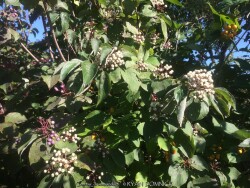

Rough-leaf dogwood is a suckering shrub or rarely a small tree to 15 ft. It is native woodland edges and tall-grass prairie ravines in Kansas olong with the Great Plains and Midwestern regions of the United States. This dogwood is easily recognized by the rough, upper leaf surfaces with flat-topped clusters of creamy-yellow flowers and white fruit on reddish brown or gray twigs. Fall color is purplish-red. Cream-white flowers about 1/4 inch wide, with 4 petals characteristic of all dogwoods. Numerous flowers are in broad clusters at the ends of branches, appearing from April to early June. White fruit then appears in late summer and early fall. A favorite of many wild birds, the fruit is usually stripped clean within a couple weeks. It spreads from root sprouts and provides cover for wildlife and erosion control along ditches. Other uses of roughleaf dogwood include buffer strip around parking lots, highway medians, dust screens along country roads, and naturalizing. It will grow in full sun or full shade in medium to dry soils including dry-shade. However, fall color is quite a bit reduced in full shade. Because of its tolerance for adverse conditions including poor soil and rock, it is often one of the last resort plants that will survive in certain areas. For the home garden, the species is generally too aggressive to mix with other plants especially when irrigated and growing in rich soil. However, in a difficult dry-shade garden, it will thrive, flower, and be relatively tame with little spreading.
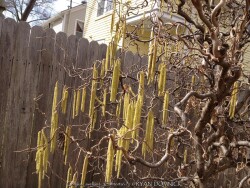

***Shrub descriptions available with future update!***Harry Lauder's Walking Stick / Contorted Filbert, is also known as Corylus avellana 'Contorta'


***Description for this plant available with future update!*** With extremely well drained soils and proper siting, this cactus seems to take our excess rainfall in Eastern Kansas. These and other hardy barrel cacti are perfect for a dry mounded xeriscape gardens under south facing roof overhangs where it gets no winter moisture. We are also testing this outside in our Lawrence, KS (zone 6a) crevice garden among other cold-hardy cacti, succulents, and yucca! Watch for future updates-Jan-2025
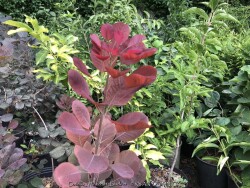

***Shrub descriptions available with future update!***>>>>>A feast for the eyes from spring through autumn! Winecraft Black® Smoketrtee (Cotinus 'Winecraft Black') is the first Proven Winners smokebush, so you know it must be special. In spring, round leaves emerge rich purple but as summer's heat comes on, they turn a deep near-black tone and finally light up in an array of reds and oranges in fall. In early summer, large, soft panicles of bloom appear that become the misty "smoke" that makes this such a popular landscape plant. Unlike other smokebush, it naturally has a rounded, dwarf habit which means that finally, every landscape has room for this unique plant. Top three reasons to grow Winecraft Black smokebush: 1.Color and interest from spring through frost. 2.No pruning or special maintenance required. 3.Dwarf habit makes it easy to use with any sized home or yard. Uses Notes: Smokebush makes a striking specimen, but is also effective as a low hedge or mass planting. Maintenance Notes: Winecraft Black smokebush is very easy to care for and requires little to nothing in the way of regular maintenance. Plant in full sun for best color and flowering. Pruning will rarely be required but may be done in spring. It isn't technically the flowers that create the hazy, smoke-like effect this plant is so loved for - it's the seed pods that form after the flowers have faded. In Eastern Kansas, this cultivar performs WELL with just about everything nature has to challenge it! Heat and drought are preferred and need hot microclimate. Cold tolerance is no problem. Some leaf disease appears by late season from excessive rains and high humidity sometimes causing early defoliation. An important note about pruning: Do not attempt to rejuvinate an older tree/shrub in early fall. This will trick it into growing back rapidly to recover and them WHAM!.Arctic cold blast arrives killing any new growth not hardened off. This double sapps the tree for nutrients usually resulting in death by spring. All Proven Winners® plants are legally propagated, healthy and vigorous, true to name, and tagged with color pictures and growing information.
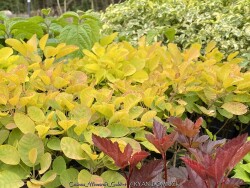

***Shrub descriptions available with future update!***>>>>>A beaming beacon for the landscape. Bold, bright, and beautiful: that's Winecraft Goldtm Smokebush (). Round, waxy leaves emerge a sunny orange, soon take on a golden hue, then mature to a cheerful chartreuse for the season. In early summer, cloud-like green flower clusters cover the plant, and these turn into the pink "smoke" plumes that earn the plant its name. Naturally grows with a dense, oval shape that's ideal for adding a spot of bright color to partially shaded or sunny areas. Top reasons to grow Winecraft Gold smokebush: 1. bright golden foliage, 2. memorable smoke-like seedheads in summer, 3. smaller and more dense than conventional smokebush. Uses Notes: Makes a lovely specimen or addition to perennial gardens and flower borders. Maintenance Notes: It's best to avoid pruning smokebush regularly, though you may selectively remove branches to attain the shape you desire. It's quite versatile and easy to grow, but do note that this golden selection is a bit less cold tolerant than other smokebush. In Eastern Kansas, this cultivar performs WELL with just about everything nature has to challenge it! Heat and drought are preferred and need hot microclimate. Cold tolerance is no problem. Some leaf disease appears by late season from excessive rains and high humidity sometimes causing early defoliation. An important note about pruning: Do not attempt to rejuvinate an older tree/shrub in early fall. This will trick it into growing back rapidly to recover and them WHAM!.Arctic cold blast arrives killing any new growth not hardened off. This double sapps the tree for nutrients usually resulting in death by spring. All Proven Winners® plants are legally propagated, healthy and vigorous, true to name, and tagged with color pictures and growing information.
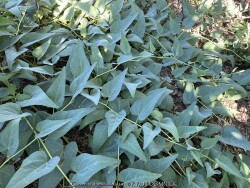

Buffalo Gourd (Cucurbita foetidissima) has large, gray-green, triangular leaves growing along long, prostrate stems. In the wild, the plants are often 20-30 feet across. Leaves are an attractive bluish green with a sandpapery texture. The large, bell-like flowers, 2-4 inches long, are yellow to orange, opening for only a day but blooming occurs over a month or so. The globular fruits, about 4 inches across, are green-striped when young, maturing to tennis-ball size and turning yellow. The plant supposedly gets the name "stink gourd" from its foul odor. Native to arid clay soils in Western Kansas, Colorado, the southwestern United States, and northern Mexico, the plant forms a fleshy tap root which is used to store water and nutrients. A large 10' wide specimen has flourished in our display garden in Lawrence, KS for over 10 years. It is planted in full sun in clay soil with no extra irrigation. It survived -16 degrees F and a week of single digit highs in February, 2021. It would be very useful as a vine-like perennial cascading over the top of a retaining wall! Amazing that a perennial native to areas receiving 5-10" of rain per year can grow in a climate receiving 5-10 times more rain!
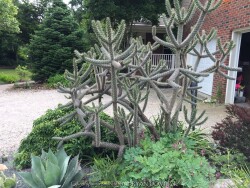

This hardy Tree / Cane Cholla variety came to us from Yucca Pointe Nursery in Stillwater, OK where it grows outside in the owner Nathan Priest's display garden. This upright Cholla Cactus (Cylindropuntia imbricata) features magenta flowers and upright growth form are a unique addition to the garden. Native to arid clay soils in Western Kansas, Colorado, Oklahoma and parts of the southwestern United States and Mexico, the plant grows into a vicious unforgiving shrub if you get too close. From a distance however, this cactus has a place as one of the few upright cacti that can handle extreme cold. In fact, I have seen this species growing a few times in Lawrence, KS in desert gardens and even in full (dry) shade! Flowering in shade is doubtful though. With well drained soils and proper siting, this cactus can handle our excess rainfall in Eastern Kansas. We are testing this outside in our crevice garden among other hardy cacti and succulents! We will keep you posted. (2024)


This hardy Klein's Cholla came to us from Oklahoma nursery near Tulsa. This upright Cholla Cactus Cylindropuntia kleiniae) features pink/magenta flowers and upright growth form are a unique addition to the garden. Native to arid clay soils in New Mexico and parts of the southwestern United States and Mexico (even possibly Oklahoma), the plant grows into a vicious unforgiving shrub if you get too close. From a distance however, this cactus has a place as one of the few upright cacti that can handle extreme cold when kept dry. With very well drained soils and proper siting, this cactus seems to take our excess rainfall in Eastern Kansas. We are testing this outside in our crevice garden among other hardy cacti and succulents! We will keep you posted. (2024)


This hardy Cane Cholla came to us from Yucca Pointe Nursery in Stillwater, OK where it grows outside in the owner Nathan Priest's display garden. This upright Cholla Cactus (Cylindropuntia spinosior) features magenta flowers and upright growth form are a unique addition to the garden. Native to arid clay soils in Western Arizona and New Mexico and parts of the southwestern United States and Mexico, the plant grows into a vicious unforgiving shrub if you get too close. From a distance however, this cactus has a place as one of the few upright cacti that can handle extreme cold when kept dry. With very well drained soils and proper siting, this cactus seems to take our excess rainfall in Eastern Kansas. We are testing this outside in our crevice garden among other hardy cacti and succulents! We will keep you posted. (2024)
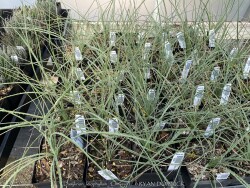

***Description for this plant available with future update!*** With extremely well drained soils and proper siting, this cactus seems to take our excess rainfall in Eastern Kansas. These and other hardy barrel cacti are perfect for a dry mounded xeriscape gardens under south facing roof overhangs where it gets no winter moisture. We are also testing this outside in our Lawrence, KS (zone 6a) crevice garden among other cold-hardy cacti, succulents, and yucca! Watch for future updates-Jan-2025
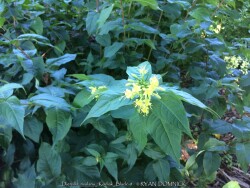

Looking for an adaptable native plant that's drought-tolerant, deer-resistant and colorful? This is it! Diervilla just got a lot more colorful: this tough, easy-growing shrub (Diervilla rivularis 'Kodiak Black') is a standout with its dark burgundy-black foliage. The color is especially intense in spring and autumn. The bright yellow flowers add contrast in early summer. This is a durable native that thrives in sun or shade, and is a very useful landscape plant.Top three reasons to grow Kodiak® Black Diervilla:1.One of the best shade-tolerant shrubs (though color is more intense in sun or part shade) 2.Never without clusters of yellow flowers during the summer 3.Dramatic black-purple foliage all season with vivid red tones in autumn. Uses Notes:Naturalizing; mass plantings. Maintenance Notes: Adaptable to most soils, including dry ones. Trim in spring and apply a controlled-release fertilizer. Though it is sometimes called "bush honeysuckle," Diervilla is not invasive. In Eastern Kansas, this cultivar performs WELL with just about everything nature has to challenge it! Heat and drought are tolerated if in shade or morning sun. Cold tolerance is no problem. No disease or pest problems. Great plant for dry-shade. Native to North America. All Proven Winners® plants are legally propagated, healthy and vigorous, true to name, and tagged with color pictures and growing information.


Looking for an adaptable native plant that's drought-tolerant, deer-resistant and colorful? This is it! Diervilla just got a lot more colorful: this tough, easy-growing shrub (Diervilla rivularis 'Kodiak Black') is a standout with its dark burgundy-black foliage. The color is especially intense in spring and autumn. The bright yellow flowers add contrast in early summer. This is a durable native that thrives in sun or shade, and is a very useful landscape plant. Now improved! Kodiak Jet Black™ diervilla is the world’s first black Diervilla that stays jet black all season long. While other diervilla tend to fade in summer, this shrub maintains its deep, striking black foliage, which creates quite the contrast with its bright yellow summer flowers. Top three reasons to grow Kodiak® Jet Black Diervilla:1.One of the best shade-tolerant shrubs (though color is more intense in sun or part shade) 2.Never without clusters of yellow flowers during the summer 3.Dramatic black-purple foliage all season with vivid red tones in autumn. Uses Notes:Naturalizing; mass plantings. Maintenance Notes: Adaptable to most soils, including dry ones. Trim in spring and apply a controlled-release fertilizer. Though it is sometimes called "bush honeysuckle," Diervilla is not invasive. In Eastern Kansas, this cultivar performs WELL with just about everything nature has to challenge it! Heat and drought are tolerated if in shade or morning sun. Cold tolerance is no problem. No disease or pest problems. Great plant for dry-shade. Native to North America. All Proven Winners® plants are legally propagated, healthy and vigorous, true to name, and tagged with color pictures and growing information.